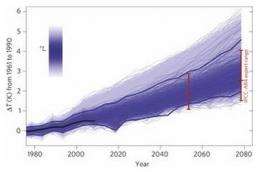March 26, 2012 report
New simulation predicts higher average Earth temperatures by 2050 than other models

(PhysOrg.com) -- Over the past several years, researchers have built a variety of computer simulations created to predict Earth’s climate in the future. Most recently, most models have suggested that over the next fifty years, we’ll see an average worldwide rise in temperature of perhaps 1°C. Now a new group of simulations, using the combined computing power of thousands of personal computers, says that number is too low, and that we might see temperatures rise as much as 3°C, which would of course, be a far more serious situation. The simulations, run by climateprediction.net in conjunction with the BBC Climate Change Experiment, resulted in predictions of a rise in temperature ranging from 1.4°C to 3.0°C by 2050. The large team involved in the project has published their findings in Nature Geoscience.
While very few if any climate scientists expect a rise of 3°C would destroy our way of life, such a change would almost certainly result in much higher ocean levels, permanently flooding many coastal areas. Many also see a rise of 2°C, as the tipping point, or point of no return, which could some time in the distant future spell doom for our species if not our planet. Many suggest that such a rise could also have a profound impact on weather systems. One recent study by a team of researchers and published in Nature Climate Change, reports on findings that suggest recent weather patterns are already showing signs of change due to global warming. A higher incidence of tornadoes in the US, a heat wave in Russian, flooding in Pakistan, etc. are all linked to elevated temperatures.
The new computer simulation model was a modification of one already used by the UK’s meteorological agency to predict global temperature changes. It was modified to more accurately take into account carbon emissions, how fast oceans absorb heat, and heat reflected back into space by aerosols in the atmosphere. The simulation was then run over 10,000 times on personal computers offered for service by home computer users, each with slightly different parameters and each covering the period 1920 to 2080. Every simulation also ran with the assumption that carbon emissions would continue to be spewed into the atmosphere at the same rate as occurs today. Once data was received from all the simulations, the researchers discarded those findings that didn’t make sense in a contextual sense. Of those remaining, none showed an increase of less than 1°C over temperatures from just a decade ago, while nearly 15% of them showed a rise of as much as 3°C by the year 2050.
While this new simulation isn’t definitive proof that temperatures worldwide will increase as much as predicted over the next thirty eight years, it most definitely is a warning that we as a species would be putting ourselves in peril if we don’t find a way to stop pumping carbon emissions into the atmosphere sooner rather than later.
More information: Broad range of 2050 warming from an observationally constrained large climate model ensemble, Nature Geoscience (2012) doi:10.1038/ngeo1430
Abstract
Incomplete understanding of three aspects of the climate system—equilibrium climate sensitivity, rate of ocean heat uptake and historical aerosol forcing—and the physical processes underlying them lead to uncertainties in our assessment of the global-mean temperature evolution in the twenty-first century1, 2. Explorations of these uncertainties have so far relied on scaling approaches3, 4, large ensembles of simplified climate models1, 2, or small ensembles of complex coupled atmosphere–ocean general circulation models5, 6 which under-represent uncertainties in key climate system properties derived from independent sources7, 8, 9. Here we present results from a multi-thousand-member perturbed-physics ensemble of transient coupled atmosphere–ocean general circulation model simulations. We find that model versions that reproduce observed surface temperature changes over the past 50 years show global-mean temperature increases of 1.4–3 K by 2050, relative to 1961–1990, under a mid-range forcing scenario. This range of warming is broadly consistent with the expert assessment provided by the Intergovernmental Panel on Climate Change Fourth Assessment Report10, but extends towards larger warming than observed in ensembles-of-opportunity5 typically used for climate impact assessments. From our simulations, we conclude that warming by the middle of the twenty-first century that is stronger than earlier estimates is consistent with recent observed temperature changes and a mid-range ‘no mitigation’ scenario for greenhouse-gas emissions.
Journal information: Nature Climate Change , Nature Geoscience
© 2012 PhysOrg.com


















